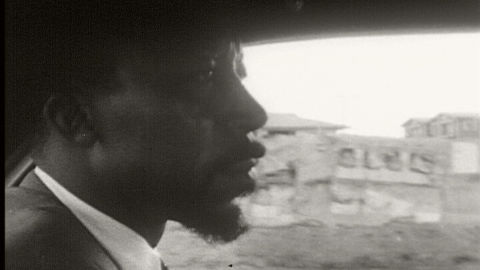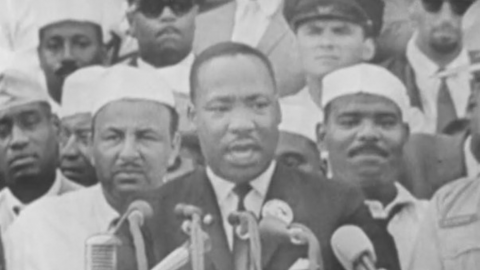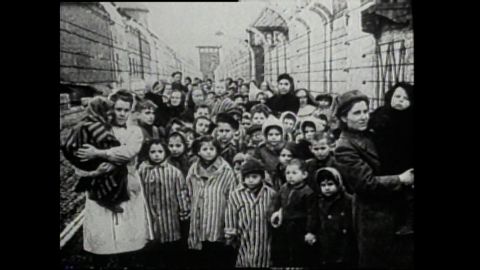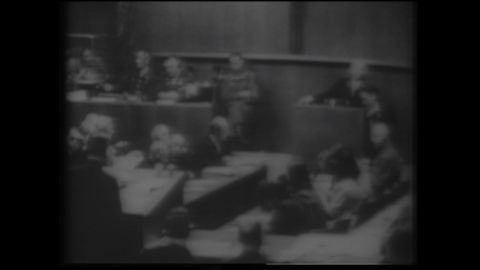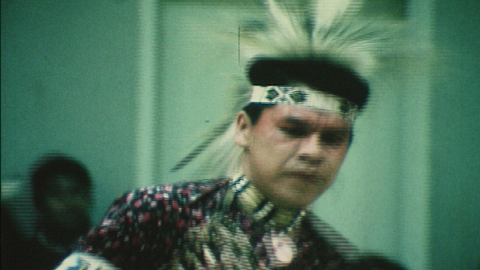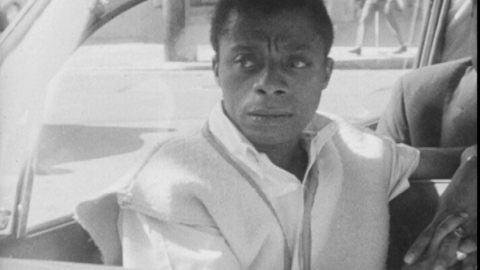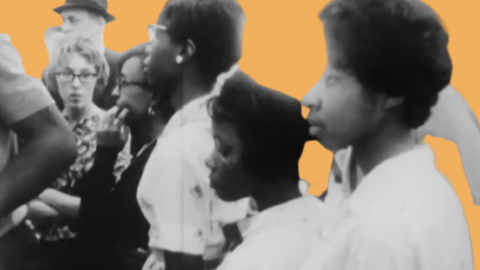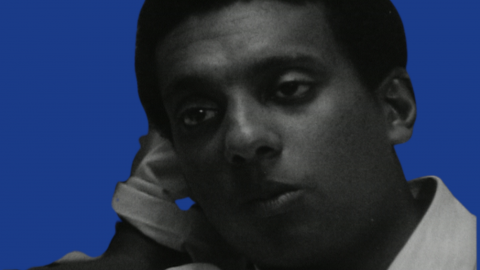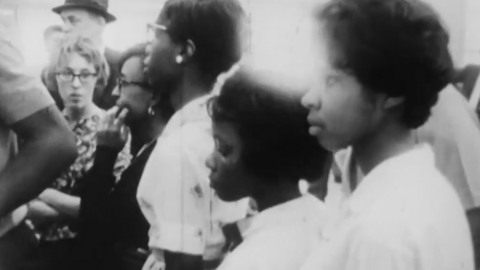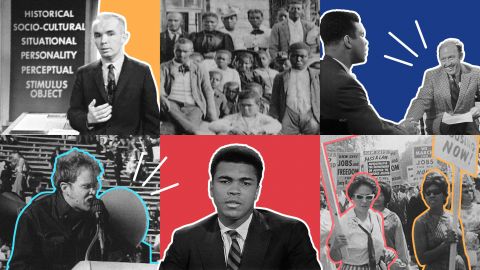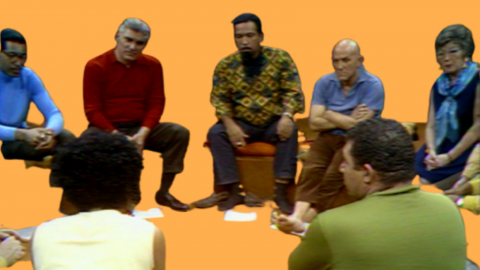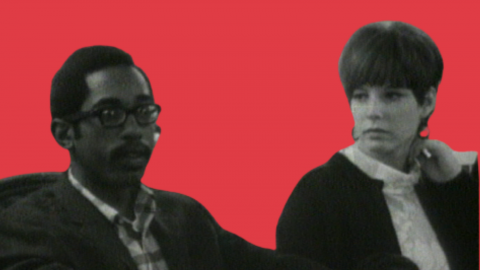[dog barking]
[woman speaks in Navajo]
- [Voiceover] My grandmother told us things
our forefathers spoke of long ago.
That when our children had learned the white man's way
and spoke his language,
and had lost the old Navajo way of living,
the world would come to an end,
and they would all be destroyed
by big winds, water, and fire.
I believe now that this may happen.
Many things that were said in the past are coming true.
Our children have been taken away.
Much of our livestock has been taken away.
Now there are wars,
and our sons are being taken to fight those wars.
[aircraft whooshes]
[woman speaks in Navajo]
- [Voiceover] The white man has invented the airplane
and other great things.
Maybe it's because they are more educated
that they can do these things.
[woman speaks in Navajo]
Navajos have been unable to create new, modern inventions,
but our old way of life,
which the Navajo people cling to,
is changing fast.
Truly as the children go to school
and learn the white man's way of living and thinking,
the old way of life will end.
This is what my grandmother told me,
and that day is here now.
- [Children] I pledge allegiance to the flag
of the United States of America,
and to the republic, for which it stands,
one nation, under God, indivisible,
with liberty and justice for all.
♪ Oh Beautiful ♪
- [Narrator] This Navajo lies one mile
from the tribal cemetery at Window Rock, Arizona,
on the white man's side of the reservation mark.
The bar is called the Navajo Inn.
20 miles away is the town of Gallup, New Mexico,
near the foothills of Mount Taylor,
one of the four sacred mountains that the old Navajo world.
There is a bar like the Navajo Inn,
or a town something like Gallup,
for every Indian tribe in the United States.
They mark the edge of what is left
of more than 300 civilizations that were here
before the white man came.
[train clanking]
The Pueblo, the Cherokee, the Chickasaw, the Choctaw,
the Creek, the Seminole, the Iroquois, the Onida,
the Seneca, the Ottawa, the Padawahan, the Wyandon,
the Kikapoo, the Shawnee,
the Winnebago, the Delaware, the Peoria, the Miami,
the Mandan, the Blackfoot, the Cheyenne, the Kiowa,
the Sui, the Nespurse, the Yute, the Bannat,
the Comanche, the Zuni, the Apache, the Hoki,
the Shashon, the Washoe, the Salish, the Tilimon,
the Modock, the Pomo, the Miwalk, the Claman,
the Hema, the Yuma, the Moavae, the Navajo.
[train clanking fades]
[wind whooshes]
[woman speaks in Navajo]
- [Voiceover] Before there were any white men,
our forefathers lived and worked according
to their own ways.
There was plenty of grass then.
And many sunflowers, and lots of wild spinach.
We had our own God, as many of us still have.
[bells rattle]
The sun,
changing woman,
first man and first woman.
The Navajo people worked very hard then,
and they planted their corn according to their own thoughts.
[man speaks in Navajo]
- [Navajo Speaker] Things that had been put there.
What are [speaks in Navajo]?
Things that were put above.
[speaks Navajo], the sun.
[speaks Navajo], the moon.
[speaks Navajo], the stars.
[speaks Navajo], things that were put on earth.
[speaks Navajo], the living things on land.
[speaks Navajo], the plant.
[shovel clanks]
[speaks Navajo]
Things that were put
for the benefit of Navajo.
[horse snorts]
[speaks Navajo], Navajo ceremony.
[horse footsteps]
[speaks Navajo], beauty way ceremony.
[horse whinnies]
[speaks Navajo], enemy way ceremony.
[men speaking Navajo]
- [Narrator] The enemy way ceremony is performed
to heal and protect a Navajo who has become ill
because of contact with the ghost of a dead enemy.
It is a ritual to renew feelings of unity and solidarity
among the people,
as the Rattlestick is carried from one camp to another,
[man sings] families and clans reciprocate
with food, song, and prayer,
and their daughters perform in the squaw dance.
The enemy way is performed many times each summer
on the Navajo reservation.
[men converse in Navajo]
- [Man] [speaks Navajo], monster slayer,
who destroyed the enemies of the Navajo people,
whose father was the sun above,
who was born for the sun to kill all evil things,
is making his staff for me.
[Navajo chanting]
The staff of the extended bowstring,
the staff of many colored, beautiful cloth.
The staff of many colored jewels.
The staff of long life and happiness.
He who gazes on my enemy is making it for me.
He has made it for me, he has brought it here for me.
He has placed it in my hand.
He has rubbed it with sacred talon.
He has rubbed it with red oak.
With my elders, he is decorating it for me.
With men and women of my clan, he has decorated it for me.
With my children and with chiefs he now carries it away
for our people to see.
Once again, all has been restored to perfect beauty.
Once again, all on the earth has been restored
to perfect harmony.
According to the inner being of the earth,
changing woman, who is life giving,
who is life sustaining,
who is life restoring.
Here it is, where all life began.
And all parts are Navajo country rejoicing has returned,
long life, harmony, and beauty have been restored.
[men chanting]
[aircraft whooshes]
[woman speaks in foreign language]
- [Voiceover] Still there is the legend
of Nawilbehe, the winner from who the white man
was destined to come.
When he was defeated by the Navajo god,
with the help of the holy people, they vowed his revenge.
"You will become my slaves again," he said.
"And I will have power over your thinking."
This is the way the old people spoke
when there were yet few white men among us.
[woman speaks foreign language]
Now our children are becoming like the white man,
and our world is coming to an end.
My grandmother said that these things would come
to pass in eight generations.
Already five generations passed
since the Navajo people were at Fort Sumner.
[men faintly chanting]
- [Narrator] Fort Sumner, New Mexico, is an empty field now.
In 1864, it was the end of a 300 mile journey
for 6,000 Navajos.
The U.S. cavalry marched the defeated tribe
through the snow, along a trail that is now Route 66.
The Navajos had been starved into surrender
by an army of settlers led by kit Carson,
hired to retaliate for Navajo raids on whites.
The Navajos lost their land and were forced to relocate
on some of the worst land in the Southwest.
The long walk to Fort Sumner
has never been forgotten by the Navajos.
[woman speaks in Navajo]
- [Narrator] The Navajos lost their sheep and their corn.
They were stolen by their enemies, the Mexicans,
the Pueblos, the Apaches and the Yutes
who started making wars that lasted a long time.
Even their women and children were stolen.
Then the white man came and burned their crops
and cut down their orchards
and burned their homes until the Navajos had nothing left.
[man speaks Navajo]
[elder speaks in foreign language]
The people had to eat sunflower seeds and wild wheat.
[Elder speaks in foreign language]
[woman speaks in foreign language]
But many starved to death.
[woman speaks in foreign language]
The starvation continued until a white man came and said
the Navajos must go to Fort Defiance
or they would all be killed.
[woman speaks in foreign language]
They walked there, but many people, including children,
died on the way.
[woman speaks in foreign language]
Some were put in wagons and the rest started on foot
for Fort Sumner.
They would change places from time to time,
but there was never enough room in the wagons.
Many who were tired and sick were shot or left behind.
[woman speaks in foreign language]
[Elder speaks in foreign language]
Many good people died at Fort Sumner
of illnesses that were strange to men.
[Elder Two speaks in foreign language]
My mother was born at Fort Sumner.
My grandmother was 14 when she went there.
Seven people in her family died at Fort Sumner;
her mother, her father, her sisters, and her brother.
[man speaks Navajo]
Government leaders
told the people to be patient,
but there was continued unrest,
and pleas to return to their own country.
Finally, a commission of white men came from Washington.
[cars whooshing]
- [Narrator] Through the treaty commission
from Washington in 1868,
the great Navajo headman, Barboncito, had said,
"I hope to God you will not ask me to go
to any other country, except my own."
The Navajo knew that all Eastern tribes had been removed
from their countries
and transported or marched West of the Mississippi.
This resulted from
president Jackson's Indian Removal Act of 1830,
which created special Indian territory in the West.
After the Civil War, the Reconstruction Congress
decided that maintaining the Navajos at Fort Sumner
costs more than keeping them on their original home site.
Barboncito's plea coincided with government economy.
So on June 18th, 1868, the Navajos left Fort Sumner
in a column 10 miles long.
More than a month later,
the Indians arrived at their homeland.
Crops, orchards, and hogans had been destroyed
In the five years since Kit Carson and the settlers invaded,
more than 3,000 Navajos had died.
[woman speaking Navajo]
- [Narrator] The government man told the Navajos
they were now in the hands of a commissioner from Washington
who would tell them what to do.
The white man said that this would never change.
Now you have a great leader who will do
all the thinking for you,
because his thoughts are far better
than the Navajo's thoughts.
Your thoughts are not so good.
You are in the hands of a great leader.
Let him plan for you.
If you let him plan for you,
you will not go into poverty anymore.
[vehicle horns]
- [Narrator] In 1849, Congress transferred
the Bureau of Indian Affairs from the War Department
to the Department of Interior.
Indians were no longer defined as hostile foreign powers,
but as an internal problem.
Congress broke hundreds of treaties and agreements
and took Indian lands, Indian food supply
and tribal authority were destroyed.
[woman speaks Navajo]
- [Voiceover] Soon after the white man came among us,
it was decided that we should have policemen
to help keep the laws.
Policemen and leaders were chosen.
This was because of government people came from Washington.
- [Narrator] In 1876, the Santa Fe Railroad pushed
through the Navajo reservation.
Sections of land on each side of the tracks were taken,
whether Indians lived there or not.
[woman speaks Navajo]
- [Voiceover] From that time on many turned
to the ways of the white man,
but the older Navajos stayed with the ways and culture
in which they were brought up.
- [Narrator] From 1870 on, missionaries and BIA officials
converged on Indian reservations.
Indian religion was prohibited
and Christianity was introduced as a U.S. government policy.
[woman speaks Navajo]
- [Voiceover] Our leaders would go to Fort Defiance
and there white men from the government would tell them
that the Navajo people must learn
the white man's way of life to stay out of poverty.
- [Narrator] By the 1940s, the government moved
toward achieving the final solution of the Indian problem
by withdrawing its services
and initiating an assimilation policy
to relocate Indians in urban areas.
- [Woman] They used to tell us about this relocation program
over the radio from Gallup.
And they explained to us that we'll be getting
about $300 each at the time.
And they were going to pay our way.
So my husband thought that it was a pretty good deal.
I thought it was going to be kind of exciting,
but it was a disappointment to us,
the way we came out here.
And when we arrived here in Oakland,
they still had the train station up there
and they told us that somebody was going to be there
waiting for us to meet us,
to take us to this place
where we were going to be staying.
And there was nobody there
from the moment we step off that train we felt sick.
[whistle]
[faint traffic]
[whistle]
[soft bell rattle]
[whistle]
[soft bell rattle]
[traffic whoosh]
[whistle]
[low chatter]
[whistle]
[soft upbeat music]
[man sings]
[soft ball thud]
[quiet chatter]
[trainers squeak]
[basketball bounces]
[soft chatter]
[man chants]
[traditional drumbeat]
[early rock and roll music]
- [Man] Yeah, this came out on relocation
and he was going to welding school
and he never drank before he came out here.
But that's the only thing there was to do
because that's where the Indians were.
- [Woman] All this time, we've been wanting to go back home,
but it seems like we never could afford to go back.
Every year we plan to go back
but something always comes up.
[train horn]
[women speaks foreign language]
- [Voiceover] Then the government men said
"Now you are going to put your children in school,
you are no longer to live according to your own ways."
They told our people that our way of thinking was not good
because we went on raids and stole things,
and we're not educated.
- [Narrator] In 1928, the Miriam report
to Congress concluded that Indian education
had been a total failure.
In 1967, the Senate subcommittee
heard new testimony from Indians.
It's conclusions were spelled out
in the title of its published report:
"Indian Education a National Tragedy, a National Challenge."
I went to the Indian schools
when I was in the elementary schools.
And we learned about the wonderful government we had
in America and how we came
and discovered this beautiful land.
Back at home, we were hearing the BIA and-
- [Narrator] David Risling spoke for a group
of California Indians.
- On this hand, we'd learned that day
you waved the flag over here,
and we'd learn about all the wonderful treaties we made
and we uphold the treaties and then go back at home
and we hear that there's not one treaty
been upheld by our government.
And pretty soon we have to decide
do we believe the teacher, or do we believe our parents?
See? Then we have the conflict.
We start arguing with their parents.
And if the parent convinces us
we'd go back and argue with the teacher.
And you can, this is just an example
of how these frustrations come about.
They can come about in religion.
We go out there.
They say that your religion is all lousy over here
but then the Jewish people come over
and the Catholics and so on people come over.
That religion is all right, but ours is all in wrong.
So we didn't have this frustration that developed
within ourselves of who is right.
What is right?
[woman speaks in Navajo]
- [Voiceover] Now the end surely it's coming.
Many of our children are in school.
When they come home to us,
they speak in a language we can't understand.
Many are even discouraged
with the way we live and say,
"Why don't you get house?
I don't like this dirt floor."
- [Children] No, no.
[indistinct]
- All right, now at the end of "lo"
the tongue must be between the teeth.
- [Narrator] Intermountain School of Brigham City, Utah,
350 miles from the Navajo reservation
is the largest co-educational boarding school
operated by the BIA.
It is an all Navajo school of more than 2100 students,
12 years or older.
A former army hospital,
the school has been in operation since 1950.
According to an Intermountain press release,
the school's purpose is to prepare young Navajos
for an active role in modern society.
Conflicts that this transition causes are described
by the principal of Intermountain, Ms. Wilma Victor.
- I think that our students encounter many kinds
of conflicts in making the transition
from the Navajo culture to the dominant culture.
There are students who are going
into a time oriented schedule.
- [indistinct] I want you to dive into the water.
[school whistle]
The Navajo culture recognizes the passage of time
for a day, by morning, noon and evening.
And when we have a highly organized school program
that has periods which lasts from 11:23 to 11:59
this kind of thing is frustrating...
[man speaks foreign language]
- [Voiceover] I was born about four miles east
of Rough Rock at a place called Yale Point.
From the age of four to seven, I herded my mother's sheep.
We used to take them to the top of Black Mesa in the summer.
When I was seven,
I was sent away to the Chinle Boarding School.
Treated us pretty rough there.
There was severe discipline and bullying the boys by boys.
[metallic swirling]
- [Wilma Victor] The importance that our society places
upon acquiring private property causes a conflict.
- Their car is better than this one.
- [Teacher] Their car is better than this one.
- Their car is better than this one.
- [Wilma Victor] The Navajo emits primitive cultural pattern
was a part of a larger group in property ownership.
Things belonged to a family
and their families are extended families
not the immediate family.
[man speaks foreign language]
- [Voiceover] After two weeks in school,
I ran away with some other boys.
Pretty soon a policeman on a horse
came to take me back from Rough Rock.
[man speaks foreign language]
When I had run away six times,
they decided to send me to this school at Fort Apache,
220 miles away.
[man on PA system]
- [Narrator] Under an Intermountain description titled
"The Student Attitude," we find the following:
"The general outward appearance of these students
is one of quietness and calmness looking deeper.
In looking deeper, however, we find withdrawal
and suppression of intense feelings.
They are in a state of insecurity as to values
because of the need to satisfactorily blend the two cultures
in their lives.
They were accustomed to failure as an academic way of life.
They failed to understand the goals
of their educational program
and therefore lack motivation to achieve these goals.
- [Voiceover] After a year at Fort Apache,
I ran away from there too
with five other boys from Rough Rock.
I was home for about a week, herding sheep and horses.
Then one day as I started out
I saw the big policeman's horse outside the hogan.
I started off on foot up a wash that leaves to Black Mesa
but I heard the hoof beats of the horse behind me.
So after my 12 day journey, I was sent back to Fort Apache.
I was nine-years-old.
The policemen followed me
on a trail back to Chinle.
A truck was there from the Fort Apache
with other boys in it.
That night they hobbled our legs together
with handcuffs and made us sleep upstairs
in the policeman's house
so we wouldn't get away.
Next morning, handcuffs on our legs were tight and pinched.
As we pulled each other along, tied together,
they put us in the truck and took us back
through Indian Wells and Show Low to Fort Apache.
For punishment, the school supervisor
put us in the girl's dress
and made us carry logs round
and round the parade ground of the old fort.
We did this all day for two weeks.
- But this, a little dot of this
on your forehead, your nose, your cheeks, and your chin.
And this is your protective cream.
So that it's protecting your skin from the makeup.
It is a shame, I think sometimes
that we have to inform them of the fact
that there isn't individual obligation to oneself to achieve
because they feel much more strongly that every individual
must be ready to share everything that he has
with someone else.
We don't teach them that this is wrong
but we do try to motivate them
to personally achieve to their highest capability.
[train horn]
[woman speaking foreign language]
- [Voiceover] Because of the new way of thinking
our children are learning the big differences developing
between parents and children.
Often we do not understand each other
and cannot communicate our thoughts and ideas.
These are the things that are happening now.
This is truly the way it is.
[wind blows]
- [Narrator] Average age of death for Indians is 44 years.
For all other Americans it is 65.
Indian infant mortality is double
that of the rest of the nation.
Average Indian income is $1,500
with a 40% unemployment rate.
In a little more than 100 years
Government policy has reduced most Indians
to poverty and lethargy.
However, signs of Indian self-assertion
began to appear in the 1960s.
Stan Steiner, author of the book "The New Indians":
- [Steiner] Red Power are two words,
and all they mean is Indian control of Indian life,
Indian development, the way Indians [indistinct]
that's all Red Power means.
And the guys who thought it up
who were a bunch of young ex-Marine Corps,
college Red Indians
thought of those words,
just to put up the hair on the backs
of every BIA administrator, paternalist,
and missionary and everyone else.
But what they're talking about are not just scare words,
what they're talking about is Indian control of Indian life.
[chanting]
- [Voiceover] Diné was the Navajo word
for the people.
And in the Rough Rock, Arizona,
near the center of the Navajo Reservation,
the Bureau of Indian Affairs
turned over a school to the Diné Corporation.
The result is the Rough Rock Demonstration School.
A school which involves the entire community
and in which an all Navajo school board elected
by the community sets policy.
- Dorm parents.
- [Narrator] Dr. Robert Russell Jr.,
who is now Chancellor of the Navajo Community College
directed the school during its first two years
and then handed over the directorship
to a Navajo: Dillon Plater.
- [Dillon] Rough Rock in a way as a symbol
Whether we're trained or untrained,
but people think whether they're educated, uneducated,
we overemphasize, I think people being educated.
Maybe they are highly educated in the Navajo way of life.
[low chattering]
- [Narrator] The Rough Rock concept is simple.
Local control and community involvement.
The teaching of Navajo language and culture,
in addition to the ABCs.
Participation of parents in their children's education.
One of the first decisions of the Board
was the dormitories should be supervised by parents.
Anita Pfeiffer is Deputy Director of the School.
- [Anita] Many of the educators and administrators have felt
that the experts have always had to be consulted
concerning education of children.
But I think that our school has demonstrated
that parents are very well versed
in what their children should learn.
- [Narrator] The Rough Rock School Board meets weekly
and the parents come together once a month.
Here, Yazzie Begay Vice Chairman of the School Board
and Anita Pfeiffer meet with parents
to explain school curriculum.
A Navajo teacher translates
for the benefit of white staff members.
[man speaking Navajo]
- [Translator] Here at the school
we want children to learn not only the English way
but the Navajo way of life.
We want them to learn to read and write.
We want them to learn the kinship system
that exists in our Navajo tribe.
- [Teacher] This is called [speaking Navajo].
[children repeat Navajo word]
Which way does it always face?
[Teacher and students speak Navajo]
- [Teacher] Towards the east,
it always faces towards the rising sun.
Willoki, would you read, please?
- [Student] In years gone by parents
trained their children to get up early in the morning.
They were told to run to the East as best as they can go.
- [Narrator] Classes at Rough Rock are ungraded
and children learn at their own rate.
- [Man] There are many schools among us.
There is your government schools,
you BI schools, some of them-
- [Anita] And some of the schools on the reservation,
the children are punished because they speak Navajo.
We feel that if the school approves
of the child speaking his own language,
that the child gets the idea
that there is something worthwhile
about his language and his culture.
[Teacher speaking Navajo]
- [Teacher] Say that.
[Student repeats in Navajo]
- [Teacher] Again. [Teacher and student speak in Navajo]
- [Teacher] No, you're saying [speaks Navajo]
You're supposed to say [speaks Navajo].
[Student speaks Navajo]
- [Student] I don't want them.
- [Teacher] These are sunflower seeds.
- Are they real?
- [Teacher] Yes, they're real.
Would you like one?
[children chatter indistinctly]
- [Teacher] Okay. Now I'm going to go out
and find some plants.
And we're going to press the plants so that they'll dry out.
And then we can put them up on boards like these over here.
Okay.
- [Student] Yeah.
- [Teacher] All right.
Let's listen carefully.
Make sure everybody understands now in Navajo.
[woman speaks in Navajo]
- [Anita] Often too, is that the children can learn
about both cultures.
They don't have to choose.
A lot of young Navajo children
don't know about their own culture.
Don't know about the Navajo history.
The myths and legends are told during the winter season.
And this is all forgotten by the children
because they're in school.
At Rough Rock we have storytellers
who come to the dormitories
and tell the children, the legends and myths.
- [Narrator] The legends are also recorded on tape
and published in books
at Rough Rock's Navajo Cultural Identification Center.
The books are widely used in many schools.
A written history of the Navajo people
in English and Navajo is now in progress.
- [Man] This is storytellers Sam Willie.
He's taping.
[Sam speaks in Navajo]
The subject is [mans speaks Navajo]
which is the the Navajo blessing way.
- [Man] We wash the main source of Navajo ceremonial way.
A long time ago.
According to the Navajo, by word of mouth,
in the creation,
is a story about white corn.
It pertains to the birth
of the young children.
And the myth goes back to the sun as a source
and a creation of the first man and the woman.
It was the school board's idea that there should be books
on Navajo legends, and Navajo history
to have something written about Navajo leaders
which Navajo children can read and look up to.
- [Teacher] Let's see if you can remember
some of the leader.
Name one.
- [Student] Narbona.
- [Teacher] Narbona.
Ganado Mucho,
We will be studying them and see what
they did in leading our people over Fort Sumner,
what they said, what they did, how they helped our people.
We will be studying them.
- [Narrator] Rough Rock serves some 100 families
in a 2000 square mile area,
more than half of the 368 students board at the school
because of impossible road conditions
on the reservation.
In spite of the distances, Rough Rock seeks
maximum community involvement.
The school provides jobs for as many local people as it can
and offers craft programs and adult education classes.
A community development project
offers milk for lambs and hay.
- [Man] If a sheep are starting out there that no other way
for the community to get help or assistance,
then if the school has any resources at all
it helps.
Another thing is they wood hauling project
from the poor families can come over here
who don't have transportation
and they can haul wood from here.
- [Narrator] Rough Rock provides summer school programs
so the children can work at home part of the time
and still keep in touch with their school work.
- [Teacher] On this side of the clock,
we say...
What?
Past. On this side of the clock, we say who?
[children murmur]
All right, you have your conjunction "and"
where does that go?
Right.
Okay.
Now we go on, we draw our line
which shows is what is your compound verb.
- [Student] There.
- [Teacher] Right?
What is, what is the verb?
- Glared and...
- [Man] Stood and glared, right?
- Stood and glared.
- [Teacher] Okay, all right.
Two subjects, two verbs.
[woman speaks Navajo]
- [Woman] How do you spell elephant?
- [Students] E-L-E-P-P-H-A-N-T
30, 40, 50, 60, 70...
[man chanting]
- [Narrator] The purpose of Rough Rocks by cultural approach
is to help Navajos to live comfortably in both worlds.
Betty Daley, one of 12 bilingual secretaries
trained by the school lives in a hogan nearby.
[heeled footsteps]
[people murmuring]
- [Anita] Many of the students who go away to school
come home and feel very uncomfortable
with their own families.
And some of them because of their two years in college
feel very superior,
but still, they don't really have a place
in the Navajo society or the Anglo society.
And they're just sort of misfits.
They go home and don't know how to make fry bread
or how to cook mutton - very little things.
How do you dry a sheepskin?
There's a proper way to do it.
If you don't know how to do it that exact way
then you're not, you're not a good Navajo.
That's really what we're doing here at Rough Rock.
The students can go home to their relatives
and operate like a Navajo, go to a middle-class home
and operate like a middle-class Anglo.
And if they know how to switch between the two, no problem.
The best part is that many of the parents are interested
in what their children are learning.
And many of them have expressed the wish
that they had this kind of a school when they grew up.
[women singing in Navajo]
- [Teacher] All right, let's go on.
- [Child] They made waterbeds of goatskin.
These could be carried on horseback.
After they learned the ways that the white man
they stopped using their grinding stone.
They bought flour and sugar,
lard, coffee at the trading post.
- [Teacher] Okay, it says after they learned the ways
of the white man they stopped using their grinding stones.
Is that true?
- [Students] No.
- [Teacher] No, we still have them, don't we?
[aircraft whooshes]
[man speaking Navajo]
- [Man] The things by which the Navajo was created.
[speaking Navajo], wood.
[speaking Navajo], fire.
[speaking Navajo], water.
[ceramic clink]
[speaking Navajo], Navajo food.
[baby cries]
[people murmur lowly]
[thunder]
[echoing clang]
[man chants]
- [Narrator] Mrs. Husba Charlie
lives near the Rough Rock school
She is one of 40,000 Navajos
who does not understand English.
Rough Rock staff member Teddy Draper
visits twice a year with many families
in the school district
to explain what is going on in the world.
This particular day, July 20th, 1968...
- Put one man on the moon.
and I'm going to ask her what they think about it.
And then...
[radio static] [indistinct talking on radio]
[beep]
[radio static] [indistinct talking on radio]
[man speaks Navajo]
[woman speaks Navajo]
- [Voiceover] The Navajo people lived
in a holy way when I was young.
And many things were kept sacred.
Today people claim there is nothing on the moon.
But when I was young,
men said there was something inside it.
I don't think men were supposed to go there.
[woman speaks Navajo]
The Navajo believe it rocks Earth,
sun, stars, moon.
Everything is a living thing.
They're careful about a lot of things because they believe
that if you're not careful, it's going to harm you.
But they're living.
[man on radio] [radio static]
- [Narrator] This cemetery is near Tuba City
on the Navajo reservation.
And many of its graves,
mark children who have succumb to malnutrition.
- [Man] Yeah, a lunar walk. [man laughs]
- [Narrator] Mr. and Mrs. Bilagody
who exist on welfare have lost a daughter, Christine.
- She didn't have enough of better food.
Would we have a better food,
it would have been different.
- [Narrator] Dr. Alberto was presently
attending another Bilagody child, Nathaniel,
for the same reason.
- [Dr.] When Christina Bilagody reached the hospital
she received the most up to date medical care
that's available.
Medically speaking, this death was not avoidable.
From a social point of view or a society point of view?
I feel like it wasn't an avoidable death.
When Nathaniel Bilagody was admitted here
at two weeks of age,
his birth weight was six pounds and four inches.
At the time of admission
he weighed scarcely four pounds, 15 ounces.
He was already very severely malnourished.
[baby cries]
He may not ever develop a normal growth pattern.
This very [indistinct] has all been inadequate.
- [Narrator] John Site is Director of Welfare
for the Bureau of Indian Affairs in Tuba City.
- [John] Lack of education started all of it.
There are all resources available to her.
Why she does not choose to avail herself
of these is an individual matter.
If a family of four has an income of $200 a month,
according to the current state standards,
based on an ATW formula
they would have sufficient income to meet their needs.
And a good manager can do exceptionally well.
A poor manager has problems.
- The problem, I really feel that a guarantee...
- [Narrator] John Aman is Welfare Officer
for the State of Arizona.
- [John] To me, it seems like a dumping ground
for surplus foods that the government buys
and then the distributors as a token gesture of mercy.
It's like a band-aid put on a big open gaping wounds.
Many people don't get their commodities
because they don't have transportation.
Many will walk miles to the warehouse
or to the pickup station and just wait there all day
'till they find someone that will take them back.
I think that I would, I would lose a certain amount
of my dignity in a sense, if I were as a Navajo,
picking up food from Washing Dawn, as they call it.
And Navajo are basically trusting,
they think this is a whole food.
This is, this comes from Washington Dawn.
This is what is given to them.
When someone's hungry
he has to go through all the rigamarole of eligibility.
Red tape, going from one agency to another.
If he has one extra child
or one lesser child that he gets less or more,
this is not, this is not honesty.
This is not humanism.
It's it has nothing to do with ethics.
It's cruel [indistinct] to me.
To me, it's another way of skirting the real issue.
The real issue of poverty and hunger.
[radio beep]
- [Houston] Columbia, this is Houston,
we'd like you to cycle [indistinct]
and fly your hydrogen tank number one.
And L-O-S [indistinct] orbit
is one, one, one, one-niner, three one.
[beeping]
Correct and make that for the next door.
But Columbia, this is Houston
- [Man On Radio] when you lose lock on us,
we request Omni-Delta.
- [Man 2 On Radio] That's okay.
- [Man 3 On Radio] That's good.
[person speaks Navajo]
- [Voiceover] People should be told not to go there.
They are doing the wrong thing.
This is why the world is in the situation it is.
And why we have no rain or vegetation.
[radio beep]
- [NASA] [indistinct] this is Houston.
F21160 [indistinct] ...
- [Neil Armstrong] ...depressed in the surface
about one or two inches
Although the surface appears to be
very, very fine grained as you get close to it.
It's almost like a powder.
[indistinct] is very fine.
The surface is fine and powdery.
- [Jack] The land is eroding away at a very rapid rate.
The vegetation that we see for thousands of acres-
- [Narrator] Jack Crowder, pilot and contractor,
builds dams for livestock.
- [Jack] Hardly any edible plants left.
There's an awful lot of wind erosion.
And, whenever it rains, there's nothing to hold the soil.
We get over this hogan you will see
this finger-like head cuts coming down the main canyon.
A little at a time, they're cutting back
until they reach the rock on the railings.
If you knew how long this took, say it took a hundred years,
you could predict the day
when there won't be any soil on the Black Mesa
unless they start managing the rain and get some vegetation,
every bit of it will be gone.
- [NASA] we can see you coming down the ladder now.
- [Broadcaster] On this day, July 20th, 1969,
Neil Armstrong, an American astronaut
becomes the first man to set foot
on the surface of the moon.
- [Neil Armstrong] That's one small step for man,
one giant leap for mankind.
- [Man] Unofficial time on the first step,
1092420.
- [Neil Armstrong] Sides of my boot.
- [NASA] Neil, this is Houston, we're copying.
- [Neil Armstrong] Here in the shadow
and a little hard for me to see that I have good footing.
I'll work my way over into the sunlight here
without looking directly-
- [Man] A lot of people are confusing
[indistinct] between culture.
White culture just came and a lot of them just got trapped.
It's just doesn't matter anymore, you know.
- [Neil Armstrong] Hey, you got it.
Beautiful. - [Man] Beautiful.
[indistinct]
- Let me tell you one thing, you know
you learn to be quiet like in a boarding school.
You come not knowing the English.
You afraid, you be afraid to speak in English
because you know, you'd be missing words.
You know, that you won't put the sentence
the way it should be.
You have feeling that you want to express with your teacher
but you don't know how to say, how to express,
because there's no nobody else in there.
That's a doubt, who'll understand you.
So, you know, you learn to be quiet.
I learned to be quiet, you know,
when I got into boarding school [indistinct].
[woman speaking Navajo]
- [Voice] The old teaching has stopped.
And now the Navajo do not know who they are.
In the old way, the Holy way,
people listened to each other's problems, but not anymore.
They spoke of many things, but not of going to the moon.
Many young people are losing the Navajo way.
I wish they still learn about these things.
[woman speaks Navajo]
- [Man] [speaks Navajo],
physical bodies.
[speaks Navajo], the soul.
[speaks Navajo], the spirit
[speaks Navajo], the thought.
[speaks Navajo],
the sound of the voice.
[children chanting]
- [Teacher] Good morning.
- [Teacher And Students] How are you?
Very well, thank you.
[Teacher speaks Navajo]
[Teacher And Students] Very well, thank you.
- [Teacher] Good morning.
- Good morning. - Good morning.
- [Teacher] How are you?
- How are you?
- Marianne McCurtain.
- [Woman] How are you?
- [Teacher] Good morning.
[woman laughs] - Good morning.
- [Man] Margaret Paul.
Sally Dick.
Otto T Draper.
- [Narrator] The month before the first American
landed on the moon
another first occurred on an Indian reservation
in a remote part of Arizona
At Rough Rock, the first graduation
at an Indian controlled school.
- [Man] Jimmy Sells.
[indistinct].
- [Narrator] Senator Edward Kennedy
addressed the graduating class.
- [Senator] After years of deportation
and degrading captivity in government boarding schools,
the Navajos had taken the first important step
towards regaining control over their educational destiny
and in, so doing Rough Rock stands as a symbol
for the improvement and the liberation
of Indian education throughout the nation.
[Barry speaks Navajo]
[children talk]
- [Man] I've been thinking if I write about Rough Rock
that I would write a piece called Laughter on the Mesa.
'Cause this is the first time I've ever been
to a Navajo school where during the class kids laugh.
I think if it's possible for kids to enjoy school,
Dillon Platero and the rest of the people
who are running this school
are establishing a basis where kids will really come back
with fond memories of having been educated in their own way.
That's Navajo power.
The Rough Rock is an example of it.
- [Man] In the past years, the hopes of Indians and others
have been woefully disappointed.
Every four years with the new administration
there is a peak period
of feeling that things are going to move forward rapidly
with boldness and with success
but we've never realized this kind of progress.
The lesson that one learns from Rough Rock
and from Navajo Community College
is that Indians have the ability
and the desire to control their destiny.
And I think that if we begin to eliminate the programs
and the policies that are founded
on the erroneous principle
that the Indian going to cease to be an Indian
and that he's going to melt in the melting pot,
I think we will take a long step towards success.
The Indian people must direct their own affairs
and determine their own educational objectives
and how these shall be met.
Indian people have got to do the talking.
[children chatter]
[bus door shuts]
- [Barry] Our students can perform right along
with any other student.
I don't think we need to take a backseat to in this area
but I think there is some reluctance on the part
of these agencies that are involved in Navajo education
so that the Rough Rock program is in a way threatening
but rather than think about their own person,
I think that we should think about the children.
[children sing]
♪ Where are you? ♪
♪ Here I am, here I am ♪
♪ How do you do? ♪
[whoosh]
[children sing]
♪ Where are you? ♪
♪ Here I am, here I am ♪
♪ How do you do? ♪
[train bell] [children sing]
♪ Where are you? ♪
♪ Here I am, here I am ♪
♪ How do you do? ♪
[children sing]
♪ Where are you? ♪
♪ Here I am, here I am ♪
♪ How do you do? ♪
[children sing]
♪ Where are you? ♪
♪ Here I am, here I am ♪
♪ How do you do? ♪
[children sing]
♪ Where are you? ♪
♪ Here I am ♪
♪ How do you do? ♪
[children sing]

